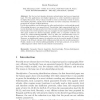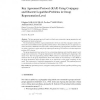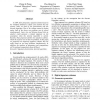56 search results - page 2 / 12 » An Efficient Group Signature Based on the Discrete Logarithm... |
CCS
2008
ACM
13 years 7 months ago
2008
ACM
Multisignatures allow n signers to produce a short joint signature on a single message. Multisignatures were achieved in the plain model with a non-interactive protocol in groups ...
SCN
2004
Springer
13 years 10 months ago
2004
Springer
Chameleon signatures were introduced by Krawczyk and Rabin, being non-interactive signature schemes that provide non-transferability. However, that first construction employs a c...
PKC
2000
Springer
13 years 8 months ago
2000
Springer
For the two last decades, electronic authentication has been an important topic. The first applications were digital signatures to mimic handwritten signatures for digital document...
INFORMATICALT
2007
13 years 5 months ago
2007
The key agreement protocol based on infinite non-commutative group presentation and representation levels is proposed. Two simultaneous problems in group representation level are ...
AINA
2003
IEEE
13 years 9 months ago
2003
IEEE
In 1994, Harn proposed a signature scheme based on the modified ElGamal's scheme and claimed that the security relies on both of the factorization and the discrete logarithm....



